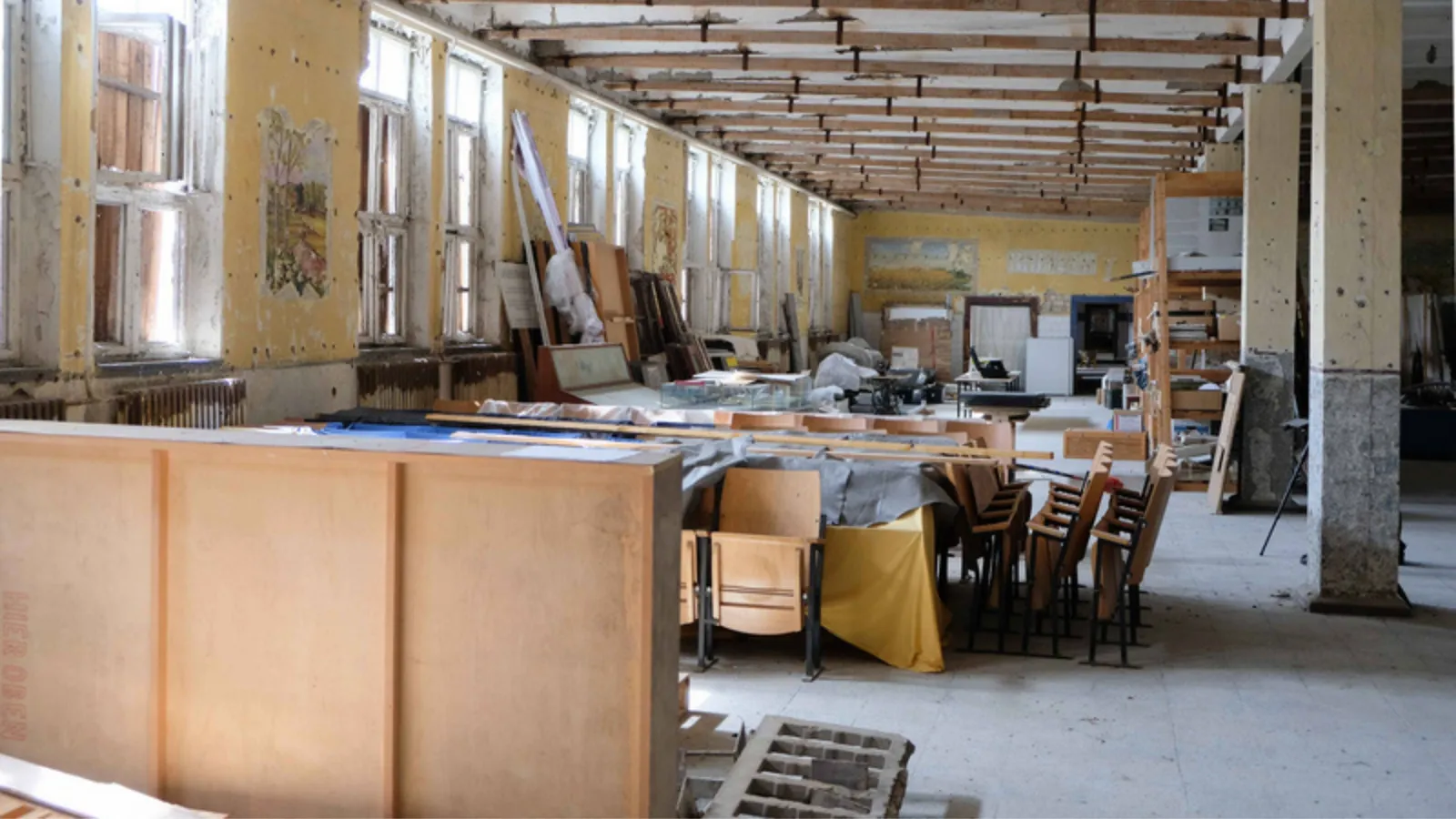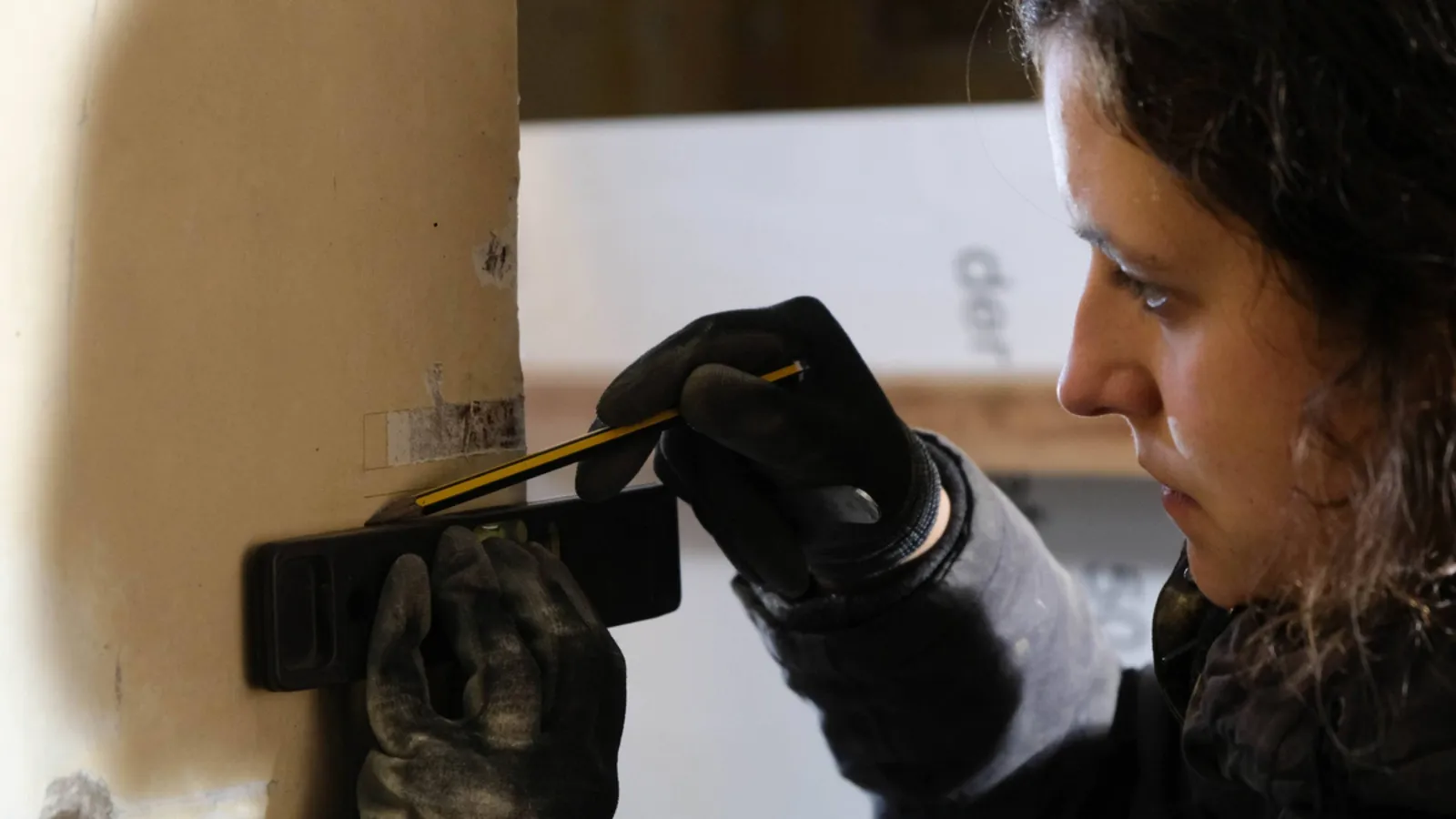Mural Painting | Ravensbrück Memorial Site, Former "Neue Wäscherei"
In addition to a general inventory of all the rooms in the elongated building of the "former ehem. Neuen Wäscherei", a colour survey was carried out within the large dining room as part of the study project.

Location: 16798 Fürstenberg/Havel , Ravensbrück Memorial Site
Object: Former "Neue Wäscherei".
Premises: Service building: former "Neue Wäscherei"; more detailed: dining room
Date of origin: 1943 - 1945
Task
Due to the very long building of the former "Neue Wäscherei" (New Laundry), the task of the project was, in addition to an overview inventory of all rooms (=> room book: creation of a floor plan (without claim to dimensional accuracy) with the numbering of all rooms), to carry out a colour investigation within the large dining room (=> own numbering: no. 6). 6), i.e. the creation of stratigraphies as well as the determination of the colour value of the determined colour layers with the NCS system, the photographing and evaluation of the findings, an archive research on the examined object and the creation of a documentation in writing and pictures. In this way, the actual state of the room cubature and furnishings, as the rooms were left by the Soviets in the 1990s, was recorded in an overview documentary form.
History
The Ravensbrück women's concentration camp was built by the SS from 1938 onwards as a so-called protective custody camp. It was built in the immediate vicinity of the town of Fürstenberg an der Havel as a complete village in its own right, with all the technical infrastructure, the housing estate for the SS personnel, road networks, railway tracks, factory buildings, barracks to house the prisoners, various functional buildings, etc. The entire site has since been largely rebuilt. In the meantime, the entire site has been largely remodelled and cleared. After the camp was taken over, it was expanded to become the second-largest site of the Soviet Army in East Germany after Wünsdorf, and consequently the buildings were used for other purposes. Due to the immediate (continued) use of the complex after 1945, at least the basic structure of the entire site has been largely preserved, as well as a considerable number of structural installations. The Soviet armed forces, who were stationed on the site of the former concentration camp until 1994, used the service building north of the camp wall as a canteen until 1994. After the withdrawal of the CIS forces, the former camp entrance area was made accessible on the 50th anniversary of liberation in 1995.
The former "Neue Wäscherei"
The building is about 88 m long and about 15 m deep with a risalit, aligned north of the camp wall in an east-west direction and covered with a flat roof. Entrance is possible from the west, south and north. There are contradictory and ambiguous statements in the literature regarding both the designation of the buildings north of the camp wall and their location. Barbara Schulz (In: Hefte der Brandenburgischen Denkmalpflege 2016/1 pp. 40 - 72) describes a building block of approx. 160 m in length, facing east-west, approved on 10.06.43 as a "laundry with prisoners' bath and delousing and disinfestation plant". On the corresponding ground plan, reference is made to another "later planned utility building", which was to be placed flush in front of the west gable of the laundry. This so-called utility building, 240 m long and with 2 side wings, was to form a three-winged complex. The neighbouring building to the east was realised with less architectural effort. The "prisoners' shower bath" and the "delousing and disinfestation plant" were set up in a barrack-like building.
The interior of the building
After measuring the rooms and drawing up a floor plan to gain an overview, the rooms were numbered clockwise from the northeast, and the numbering was referred to in the overall documentation. A room book with photographic insights and, in some cases, detailed photos was prepared in which all rooms with their respective furnishings were recorded with a brief written description of the conspicuous features and, if applicable, details of their presumed use. At the time the room book was compiled, there were a total of 20 rooms within the elongated building.
Description of Room No. 6
In Room 6 of the former "Neue Wäscherei" there are a total of 17 decorative motifs running around the walls, on the north and south walls between the window axes in each case, on the east wall around the two passages, on the west wall also above the passages. These are partly in the form of stuccowork, partly as paintings as well as in mixed forms of both techniques, as the paintings were additionally provided with a raised stucco frame. In the course of renovation work between 1988/89 and 1994, all four walls were presumably covered with pressed wood panels, as indicated by the regular dowel holes (some with wooden dowels still present), on which the corresponding battens were screwed in order to apply the respective coverings. To carry out this measure, the paintings that had been visible until then were perforated, as it were, and the raised stucco work was knocked off, thus levelling it. With the departure of the troops, the panelling was obviously unscrewed, right down to all the materials serving the construction, and perhaps taken away with them.
At the time of our examination campaign, the paintings were thus once again in an "exposed", but equally ruinous state. The paint layer was rolling up and flaking off very badly due to a lack of connection to the completely suppressed, strongly powdery lemon yellow distemper painting underneath and the dramatic climatic conditions due to the open windows and years of vacancy.
Summary of the findings
Obviously, about half of the originally planned commercial building was realised, namely only the eastern area including the central risalit, and this only as a one-storey building with completion of the covering cap vault. The windows that still exist today may have been installed by 1945 as a prerequisite for the interior construction. The plastering of the interior (at least in room 6 as the large hall room) was done up to the top of the cap vault. An overall white paint job was also carried out in the entire room, which presumably extended over the entire building wing up to the central risalit, including the ceiling. Immediately after the Soviets took over the building, however, it was subdivided into a large number of rooms over the next few years by means of room-dividing walls and the construction for suspending the ceiling, which was accompanied by the first colour scheme in Room 6. Contrary to its originally planned use as a laundry, the entire building was converted by the Soviets into a kitchen and canteen wing, and the rooms were rebuilt and equipped accordingly for these purposes. In the course of time, several coats of paint were applied and tile mirrors were installed in the utility rooms, but these measures cannot be dated. The recent layer of paint with paintings and stuccowork dating from 1986 can be dated with certainty by the signatures still present. The last paintings on the west wall were carried out in 1988. Immediately afterwards, the flat wall coverings were applied, for which all wall areas were perforated with dowel holes in a systematic sequence in preparation for the construction. When the Soviet troops withdrew, these were removed again, so that today the design condition of 1986-1988 is still visible.
Publication
Eschebach, Tjalda (2020): The building of the former "New Laundry" in Ravensbrück. An inventory and investigation of the historical colourfulness. In: Petra Fank (ed.), Sabine Arend (ed.): Ravensbrück denken. Gedenk- und Erinnerungskultur im Spannungsfeld von Gegenwart und Zukunft, Berlin 2020, p. 48. - 56. summary
Project participants
Project support
Project mediation
- Dr Insa Eschebach
- Dr Sabine Arend
Students
- Lis Mette Eggers
- Hans-Christian Klein
- Margarete Piehl
- Kilian Wachowiak






